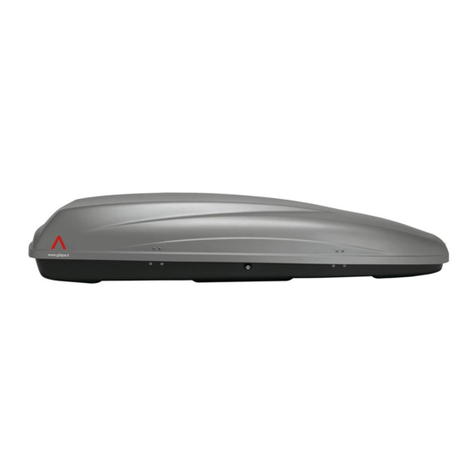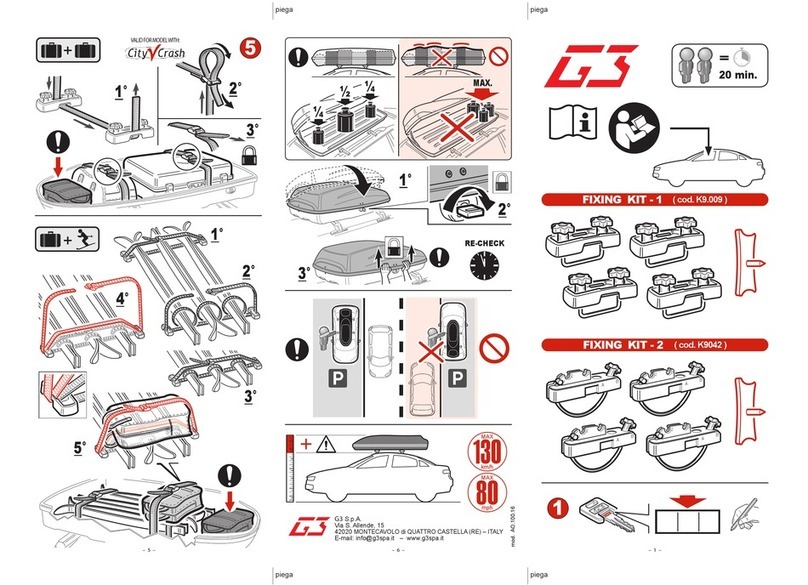
8
SCT/SCTHD
ed. 02/2020
• È vietato utilizzare l’attrezzatura aperta o semichiusa
per comprimere i materiali.
• È vietato utilizzare l’attrezzatura per impieghi diversi
da quelli precedentemente descritti, come strappare
o trainare qualsiasi oggetto in quanto l’attrezzatura,
l’interfaccia e un’eventuale rotore, sono progettati
per sopportare solo carichi verticali.
• È assolutamente vietato il sollevamento e la presa
di persone o animali.
• È assolutamente vietato abbandonare la macchina
con carichi sospesi.
• È assolutamente vietato transitare nel raggio di
azione in cui la macchina e l’attrezzatura operano.
Non utilizzare l’attrezzatura se non si è prima
provveduto a recintare l’area di lavoro impedendo
l’accesso di persone e di animali. Qualora non fosse
possibile recitare l’area di manovra, è responsabilità
dell’operatore accertarsi che non ci siano persone o
animali nel raggio di 20 metri.
1.5 - LIMITAZIONI D’USO
• Evitare l’utilizzo dell’attrezzatura in ambienti a
contatto con acqua marina o salmastra e in condizioni
atmosferiche particolarmente sfavorevoli.
• In caso di movimentazione di materiali caldi o di
materiale sfuso a grana fine, è bene procedere
all’ingrassaggio dei componenti una volta al giorno.
• Prestare particolare attenzione alla natura dei
materiali perchè non è sempre possibile ottenere
una presa sicura mediante l’attrezzatura.
• Temperatura di utilizzo: da –15° a +40°C.
• La pressione di esercizio prescritta (vedi tabella a
pag. 13) non può essere superata; in caso contrario
è possibile la rottura di determinate componenti
dell’attrezzatura.
1.6 - DESCRIZIONE ATTREZZATURA
L’attrezzatura della serie SCT è destinata alla raccolta e
movimentazione di materiali sfusi come: rottame ferroso o
metallico, trucioli, detriti, scarti di lavorazione in generale,
vetro, macerie, rifiuti, ecc..
La serie SCT viene prodotta in vari modelli differenti ed
ognuno di essi può essere dotato, anche dopo la vendita,
di 4 tipi di attacchi:
• tipo PE = flangia standard 173/6.
• tipo K (6 ton) = attacco femmina con rotazione
idraulica a 360° continua incassata, capacità di
sollevamento 60 kN..
• tipo K1 (10 ton) = attacco femmina con rotazione
idraulica a 360° continua incassata, capacità di
sollevamento 100 kN..
• tipo K2 (G131) = attacco femmina con rotazione
idraulica a 360° continua incassata G131
Ognuno di questi modelli è equipaggiato con:
• pala tipo 0 = pala chiusa.
Ogni pala è indipendentemente movimentata da cilindri
oleodinamici a doppio effetto.
NOTA
Nel caso sia presente il rotatore idraulico, consultare
il relativo manuale per quanto riguarda montaggio,
portata, pressione di esercizio e manutenzione.
• It is prohibited to use the equipment for purposes
different from those previously described, such as to
tear or tow any object, as the equipment, interface
and any rotor, are designed only to vertically support
loads.
• It is absolutely prohibited to lift and take hold of
persons or animals.
• It is absolutely prohibited to leave the machine with
suspended loads.
• It is absolutely forbidden to pass within range of the
machine and equipment in which they operate.
Do not use equipment before providing for the fencing
of the working area to prevent access of people and
animals. Whenever it is not possible to fence the area
of movement, it is the responsibility of the operator to
ascertain that there are no people or animals within
a radius of 20 meters.
1.5 - LIMITATIONS OF USE
• Avoid the use of the equipment at an ambient in
contact with sea water or brackish water and in
conditions of particularly bad weather.
• When handling hot material or fine-grained bulk
material, it is good practice to proceed with greasing
components once a day.
• Pay particular attention to the nature of material
because it is not always possible to obtain a secure
grip by meanss of the equipment.
• Usage temperature range: -15° to +40°C.
• The prescribed working pressure (see the Table on
Page. 13) can not be exceeded; otherwise, certain
components of the equipment can break.
1.6 - DESCRIPTION OF EQUIPMENT
The equipment series SCT is intended for the collection
and handling of bulk materials such as: or ferrous or
metal scrap, shavings, debris, discarded work materials
in general, glass, rubble, refuse, etc.
The series SCT is produced in various different models
and each of these can be equipped, even after sales, with
4 types of connections:
• type PE = standard flange connection 173/6
• type K (6 ton) = female connection with 360°
continuous hydraulic rotation, recessed, 60 kN lifting
capacity.
• type K1 (10 ton) = female connection with 360°
continuous hydraulic rotation, recessed, 100 kN
lifting capacity.
• type K2 (G131) = female connection with 360°
continuous hydraulic rotation, recessed, G131
Each of these models is equipped with:
• Blade type 0 = closed.
Each blade is independently operated by double-acting
hydraulic cylinders.
NOTE
In cases where the hydraulic rotator is present,
consult the the related manual as regards mounting
capacity, pressure and maintenance.































